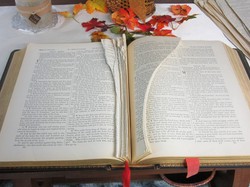At 6:45 on the morning of Saturday, Oct. 1, Charlie Richardson, building and grounds supervisor of First Presbyterian Church in Madison, SD, was awakened by a phone call from local police. The church building had been broken into overnight. The vandals stole nothing, but left a swath of destruction in their wake.
“There was glass all over the tables and chairs, the window sills, and in the furnace vents,” Richardson says of the children’s education room where the vandals gained entrance.
The biggest emotional loss, Richardson adds, was “handfuls of pages that were ripped from the historic Bible in the fellowship hall. It looked like they had run all over the room scattering pages.”
A wooden cross had been hurled at the wall, displacing a chunk of plaster, Richardson says. Pottery lay smashed on the kitchen floor. In the sanctuary, the heavy wooden pulpit had been dumped into the Communion table. Communion bread had been flung throughout the pews. The silver Communion bread plates were crushed and the silver chalice looked as if “they had taken their feet and smashed it.”
“They attacked religious items,” Richardson says. “It looked like they were anti-Christian.”
It’s a morning members of the congregation will never forget — but not necessarily because of the damage.
What stands out most is what happened afterward.
“The response was truly awesome,” says the Rev. Sandra Larson, First Church’s pastor. “A rallying cry went out, and people were here as early as seven in the morning. As soon as we were cleared by the insurance company, the clean-up process began.”
More than 20 people in a congregation of around 100 members dropped their Saturday plans to come to the aid of the church. One member’s construction company secured the building. Communion bread was re-baked. For more than eight hours, vacuum cleaners hummed, shards of broken pottery crashed into garbage cans, beloved objects were repositioned or sent for repair. A pottery goblet was located for Sunday’s celebration of communion. Dinner plates were set out for most of the bread.
Throughout the day, prayers of thanksgiving were offered for what had not been damaged, including irreplaceable liturgical art.
It was emotional work and scars remain. The front pew is chipped, the pulpit is scratched, a panel of stained glass is cracked. Flecks of unreachable glass sparkle from deep within the carpet of the children’s room.

An historic Bible whose pages were torn out was the most grievous loss in the vandalism attack. —Lori Walsh
Richardson and other members of the congregation report feeling anger, sadness, and every emotion in between. “It feels as if our own home was broken into,” Larson says. “There is a feeling of vulnerability.”
“We used to think Madison was a safe town,” says Elder Donita Balogh.
“I’d like to know what was going through their minds,” Richardson adds.
Madison has 6,500 residents, including around 1,500 students attending the local Dakota State University, according to Detective Sergeant Justin Meyer of the Madison Police Department.
Once every two to three years, he says, the police see what they describe as “some kind of juvenile crime spree.” At press time, there are no suspects, and police are actively investigating.
Meyer says the police logged 12 to 15 incidents that evening, with damage at First Presbyterian being the most extensive. Madison saw two stolen vehicles, a stolen all-terrain vehicle, a spray-painted vehicle, destruction of car windows and decorative home lights, as well as damage to a fence outside a Catholic school and a broken flowerpot at the Methodist church.
“I think what we have (at First Presbyterian) is simply a crime of opportunity,” Meyer says. “I think we have some extremely drunk individuals, or individuals on drugs, and they just went on a spree.”
Larson does not believe the PC(USA) was targeted. First Presbyterian Church has several windows that are low to the ground and out of sight of the main road.
But she does believe, and the nature of the crime supports, that the vandals were intentional about damaging items of faith.
“I’m convinced that it wasn’t this [particular] congregation they were angry at,” Larson says. “The real question is, can we use this as a parable? It does look like this was motivated by anger. What can we do as a community of faith to foster the spirit of Christ in a way that doesn’t produce such outbursts of anger?”
The lesson commenced, Larson maintains, on that Saturday, when everyone pulled together to pick up the pieces, and continued on Sunday morning, when she adapted her sermon to include a message of forgiveness and an elder offered the vandals up for congregational prayer.
It continues, Larson adds, if and when the suspects are ever brought to justice.
“There is a difference between secular justice and the Presbyterian justice system,” Larson says. “This includes both consequences and reconciliation. The reconciliation process can be much more rewarding.”
A brass-plated cross, engraved in 1953, stands on the Communion table. The cross was crushed under the pulpit and is now bent, but could perhaps be repaired. First Presbyterian member Janet Weber suggests that the cross be left in its damaged state.
“It gives us an opportunity to recognize that people have different opinions,” she says. “It’s a reminder of trials and forgiveness.”
Balogh agrees.
“The cross might be bent, but together we’ll survive this.”
Lori Walsh is a freelance journalist from Sioux Falls, SD.

